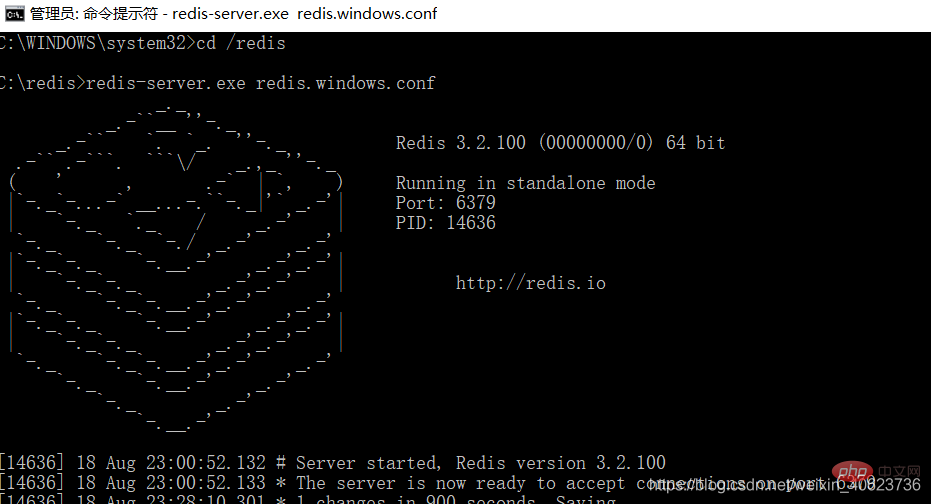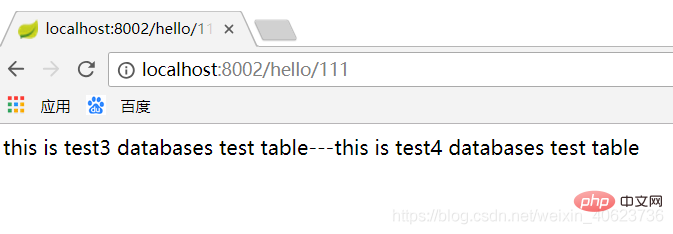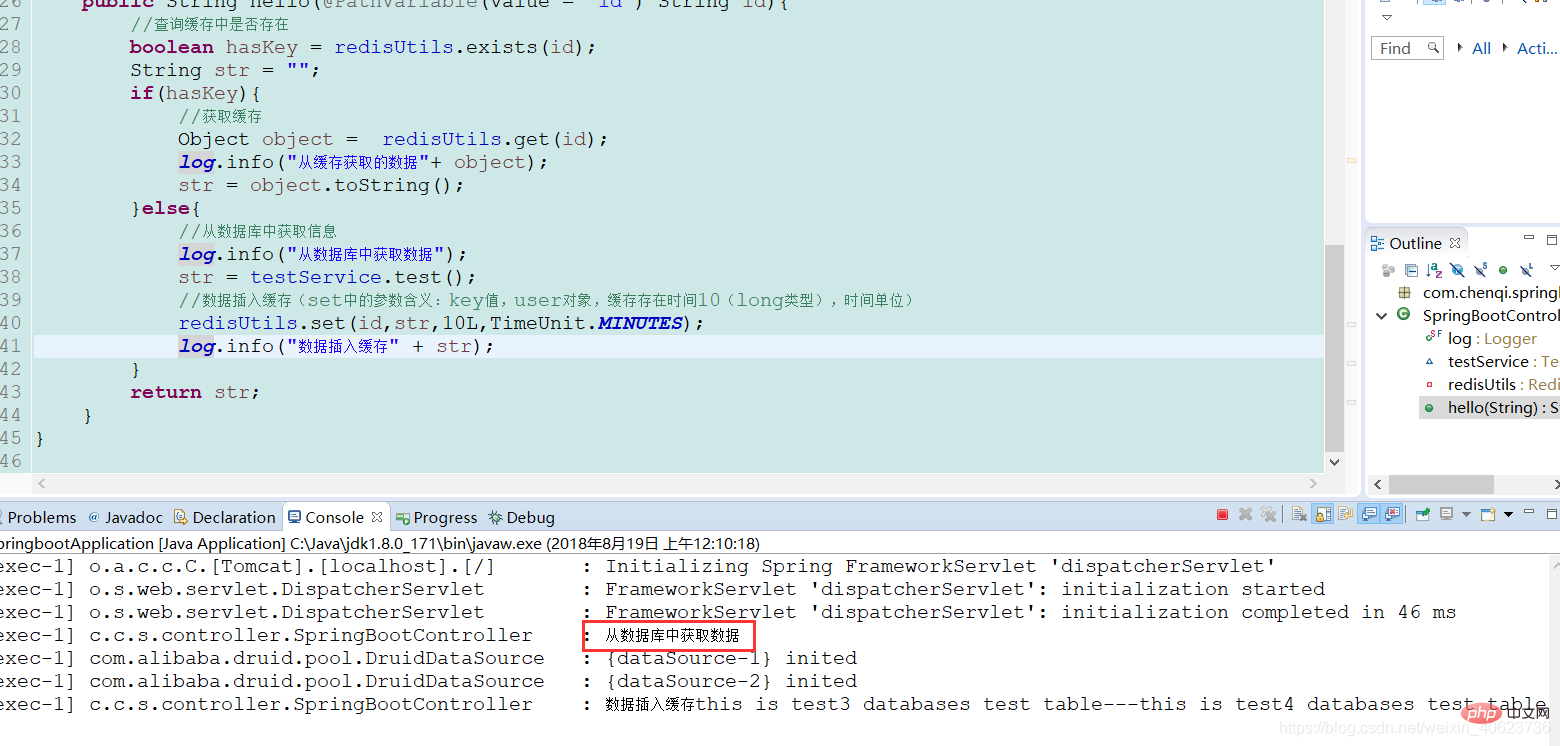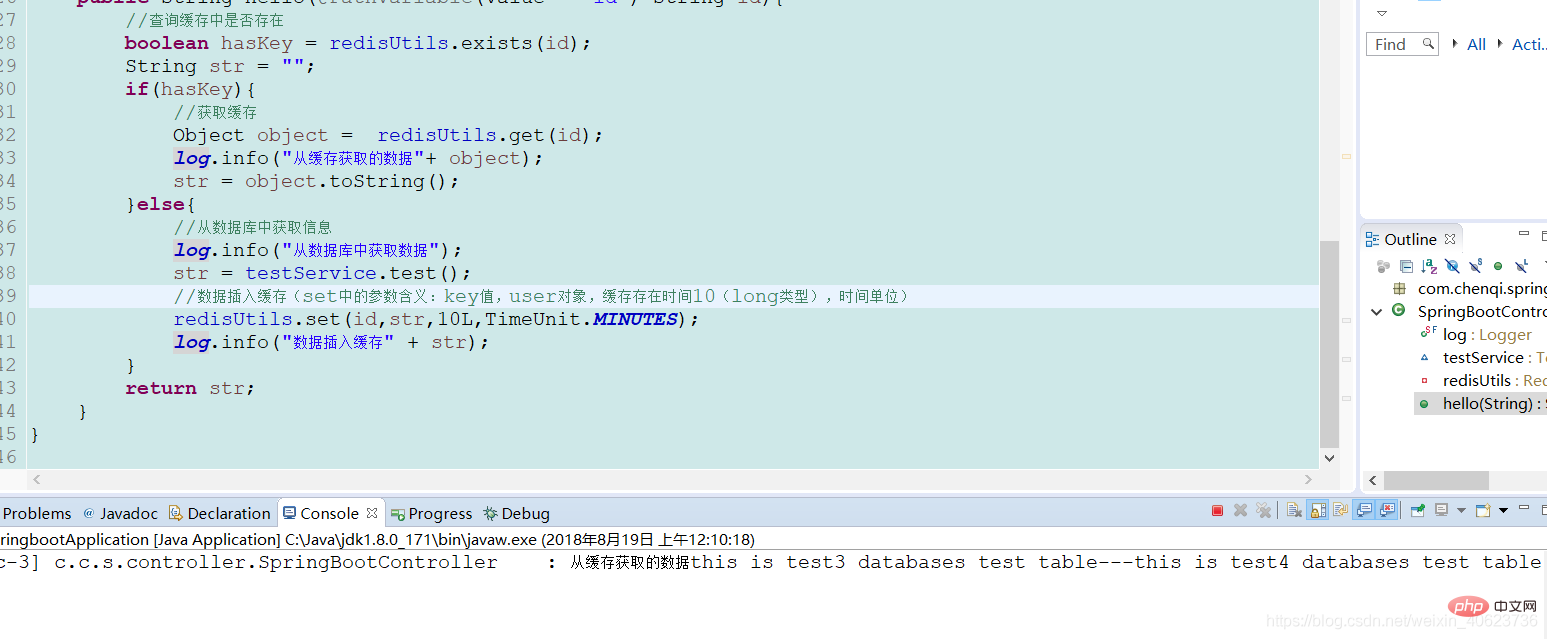springBoot를 사용하여 Redis를 통합하는 방법은 무엇입니까?
- 青灯夜游앞으로
- 2021-04-22 10:22:452017검색
이 글에서는 springBoot를 사용하여 Redis를 통합하는 방법을 소개합니다. 도움이 필요한 친구들이 모두 참고할 수 있기를 바랍니다.

REmote DIctionary Server(Redis)는 Salvatore Sanfilippo가 작성한 키-값 저장 시스템입니다.
Redis는 ANSI C 언어로 작성된 오픈소스 로그형 Key-Value 데이터베이스로, BSD 프로토콜을 준수하고, 네트워크를 지원하며, 메모리 기반 및 영속성이 가능하며, 다국어로 API를 제공합니다. [관련 추천: Redis 영상 튜토리얼]
값이 문자열(String), 해시(Map), 목록(list), 컬렉션(sets) 및 Sorted일 수 있으므로 데이터 구조 서버라고도 합니다. 세트 및 기타 유형.
reids의 장점
Redis의 장점은 다음과 같습니다.
매우 빠릅니다. Redis는 매우 빠르며 초당 약 110,000개의 세트(SET) 작업과 초당 약 81,000개의 읽기 Get/get(GET)을 수행할 수 있습니다. ) 작업.
다양한 데이터 유형 지원 - Redis는 목록, 세트, 정렬된 세트, 해시 등과 같이 개발자가 일반적으로 사용하는 대부분의 데이터 유형을 지원합니다. 이를 통해 Redis를 사용하여 다양한 문제를 쉽게 해결할 수 있습니다. 어떤 데이터 유형을 사용하면 어떤 문제를 더 잘 해결할 수 있는지 알 수 있기 때문입니다.
원자성 작업 - 모든 Redis 작업은 원자성이므로 두 클라이언트가 동시에 액세스하는 경우 Redis 서버가 업데이트된 값을 받을 수 있습니다.
다중 유틸리티 도구 - Redis는 캐싱, 메시지 대기열(Redis는 기본적으로 게시/구독 지원), 애플리케이션의 단기 데이터 등 다양한 사용 사례에 사용할 수 있는 다중 유틸리티 도구입니다. , 웹 애플리케이션 세션, 페이지 조회수 등
Redis 설치
Window 아래 설치
다운로드 주소: https://github.com/MSOpenTech/redis/releases.
Redis는 32비트와 64비트를 지원합니다. 이는 시스템 플랫폼의 실제 상황에 따라 선택해야 합니다. 여기서는 Redis-x64-xxx.zip 압축 패키지를 C 드라이브에 다운로드합니다. 압축을 푼 후 폴더 이름을 redis로 바꿉니다.
cmd 창을 열고 cd 명령을 사용하여 디렉터리를 C: redis로 전환합니다.
Run redis-server.exe redis.windows.conf
더 편리하게 하려면 시스템 환경 변수에 redis 경로를 추가하면 됩니다. 경로를 다시 입력해야 합니다. redis.windows.conf를 생략하면 기본 경로가 활성화됩니다. 입력 후 다음 인터페이스가 표시됩니다.

Integrate redis
우리는 여전히 이전 장의 프로젝트를 사용합니다. Springboot는 springcloud-config를 통합하여 dataSource 핫 배포를 구현합니다
1.
<!--集成redis-->
<dependency>
<groupId>org.springframework.boot</groupId>
<artifactId>spring-boot-starter-redis</artifactId>
<version>1.4.1.RELEASE</version>
</dependency>
<dependency>
<groupId>com.alibaba</groupId>
<artifactId>fastjson</artifactId>
<version>1.2.3</version>
</dependency>
<dependency>
<groupId>com.fasterxml.jackson.core</groupId>
<artifactId>jackson-databind</artifactId>
</dependency> 2. 구성 센터에 redis 구성을 추가합니다
spring.redis.host=127.0.0.1 #Redis服务器连接端口 spring.redis.port=6379 #Redis服务器连接密码(默认为空) spring.redis.password= #连接池最大连接数(使用负值表示没有限制) spring.redis.pool.max-active=8 #连接池最大阻塞等待时间(使用负值表示没有限制) spring.redis.pool.max-wait=-1 #连接池中的最大空闲连接 spring.redis.pool.max-idle=8 #连接池中的最小空闲连接 spring.redis.pool.min-idle=0 #连接超时时间(毫秒) spring.redis.timeout=30000
3. 구성 클래스 RedisConfig
import java.lang.reflect.Method;
import org.springframework.beans.factory.annotation.Value;
import org.springframework.cache.CacheManager;
import org.springframework.cache.annotation.CachingConfigurerSupport;
import org.springframework.cache.annotation.EnableCaching;
import org.springframework.cache.interceptor.KeyGenerator;
import org.springframework.cloud.context.config.annotation.RefreshScope;
import org.springframework.context.annotation.Bean;
import org.springframework.context.annotation.Configuration;
import org.springframework.data.redis.cache.RedisCacheManager;
import org.springframework.data.redis.connection.RedisConnectionFactory;
import org.springframework.data.redis.connection.jedis.JedisConnectionFactory;
import org.springframework.data.redis.core.RedisTemplate;
import org.springframework.data.redis.core.StringRedisTemplate;
import org.springframework.data.redis.serializer.Jackson2JsonRedisSerializer;
import com.fasterxml.jackson.annotation.PropertyAccessor;
import com.fasterxml.jackson.annotation.JsonAutoDetect;
import com.fasterxml.jackson.databind.ObjectMapper;
@Configuration
@EnableCaching
@RefreshScope
public class RedisConfig extends CachingConfigurerSupport{
@Value("${spring.redis.host}")
private String host;
@Value("${spring.redis.port}")
private int port;
@Value("${spring.redis.timeout}")
private int timeout;
@Value("${spring.redis.password}")
private String password;
@Value("${spring.redis.pool.max-active}")
private int maxActive;
@Value("${spring.redis.pool.max-wait}")
private int maxWait;
@Value("${spring.redis.pool.max-idle}")
private int maxIdle;
@Value("${spring.redis.pool.min-idle}")
private int minIdle;
@RefreshScope
@Bean
public KeyGenerator wiselyKeyGenerator(){
return new KeyGenerator() {
@Override
public Object generate(Object target, Method method, Object... params) {
StringBuilder sb = new StringBuilder();
sb.append(target.getClass().getName());
sb.append(method.getName());
for (Object obj : params) {
sb.append(obj.toString());
}
return sb.toString();
}
};
}
@RefreshScope
@Bean
public JedisConnectionFactory redisConnectionFactory() {
JedisConnectionFactory factory = new JedisConnectionFactory();
factory.setHostName(host);
factory.setPort(port);
factory.setTimeout(timeout); //设置连接超时时间
factory.setPassword(password);
factory.getPoolConfig().setMaxIdle(maxIdle);
factory.getPoolConfig().setMinIdle(minIdle);
factory.getPoolConfig().setMaxTotal(maxActive);
factory.getPoolConfig().setMaxWaitMillis(maxWait);
return factory;
}
@RefreshScope
@Bean
public CacheManager cacheManager(RedisTemplate redisTemplate) {
RedisCacheManager cacheManager = new RedisCacheManager(redisTemplate);
// Number of seconds before expiration. Defaults to unlimited (0)
cacheManager.setDefaultExpiration(10); //设置key-value超时时间
return cacheManager;
}
@RefreshScope
@Bean
public RedisTemplate<String, String> redisTemplate(RedisConnectionFactory factory) {
StringRedisTemplate template = new StringRedisTemplate(factory);
setSerializer(template); //设置序列化工具,这样ReportBean不需要实现Serializable接口
template.afterPropertiesSet();
return template;
}
@RefreshScope
private void setSerializer(StringRedisTemplate template) {
Jackson2JsonRedisSerializer jackson2JsonRedisSerializer = new Jackson2JsonRedisSerializer(Object.class);
ObjectMapper om = new ObjectMapper();
om.setVisibility(PropertyAccessor.ALL, JsonAutoDetect.Visibility.ANY);
om.enableDefaultTyping(ObjectMapper.DefaultTyping.NON_FINAL);
jackson2JsonRedisSerializer.setObjectMapper(om);
template.setValueSerializer(jackson2JsonRedisSerializer);
}
}4. RedisUtils 클래스
import java.io.Serializable;
import java.util.List;
import java.util.Set;
import java.util.concurrent.TimeUnit;
import org.springframework.beans.factory.annotation.Autowired;
import org.springframework.data.redis.core.HashOperations;
import org.springframework.data.redis.core.ListOperations;
import org.springframework.data.redis.core.RedisTemplate;
import org.springframework.data.redis.core.SetOperations;
import org.springframework.data.redis.core.ValueOperations;
import org.springframework.data.redis.core.ZSetOperations;
import org.springframework.stereotype.Service;
@Service
public class RedisUtils {
@Autowired
private RedisTemplate redisTemplate;
/**
* 写入缓存
* @param key
* @param value
* @return
*/
public boolean set(final String key, Object value) {
boolean result = false;
try {
ValueOperations<serializable> operations = redisTemplate.opsForValue();
operations.set(key, value);
result = true;
} catch (Exception e) {
e.printStackTrace();
}
return result;
}
/**
* 写入缓存设置时效时间
* @param key
* @param value
* @return
*/
public boolean set(final String key, Object value, Long expireTime ,TimeUnit timeUnit) {
boolean result = false;
try {
ValueOperations<serializable> operations = redisTemplate.opsForValue();
operations.set(key, value);
redisTemplate.expire(key, expireTime, timeUnit);
result = true;
} catch (Exception e) {
e.printStackTrace();
}
return result;
}
/**
* 批量删除对应的value
* @param keys
*/
public void remove(final String... keys) {
for (String key : keys) {
remove(key);
}
}
/**
* 批量删除key
* @param pattern
*/
public void removePattern(final String pattern) {
Set<serializable> keys = redisTemplate.keys(pattern);
if (keys.size() > 0){
redisTemplate.delete(keys);
}
}
/**
* 删除对应的value
* @param key
*/
public void remove(final String key) {
if (exists(key)) {
redisTemplate.delete(key);
}
}
/**
* 判断缓存中是否有对应的value
* @param key
* @return
*/
public boolean exists(final String key) {
return redisTemplate.hasKey(key);
}
/**
* 读取缓存
* @param key
* @return
*/
public Object get(final String key) {
Object result = null;
ValueOperations<serializable> operations = redisTemplate.opsForValue();
result = operations.get(key);
return result;
}
/**
* 哈希 添加
* @param key
* @param hashKey
* @param value
*/
public void hmSet(String key, Object hashKey, Object value){
HashOperations<string> hash = redisTemplate.opsForHash();
hash.put(key,hashKey,value);
}
/**
* 哈希获取数据
* @param key
* @param hashKey
* @return
*/
public Object hmGet(String key, Object hashKey){
HashOperations<string> hash = redisTemplate.opsForHash();
return hash.get(key,hashKey);
}
/**
* 列表添加
* @param k
* @param v
*/
public void lPush(String k,Object v){
ListOperations<string> list = redisTemplate.opsForList();
list.rightPush(k,v);
}
/**
* 列表获取
* @param k
* @param l
* @param l1
* @return
*/
public List<object> lRange(String k, long l, long l1){
ListOperations<string> list = redisTemplate.opsForList();
return list.range(k,l,l1);
}
/**
* 集合添加
* @param key
* @param value
*/
public void add(String key,Object value){
SetOperations<string> set = redisTemplate.opsForSet();
set.add(key,value);
}
/**
* 集合获取
* @param key
* @return
*/
public Set<object> setMembers(String key){
SetOperations<string> set = redisTemplate.opsForSet();
return set.members(key);
}
/**
* 有序集合添加
* @param key
* @param value
* @param scoure
*/
public void zAdd(String key,Object value,double scoure){
ZSetOperations<string> zset = redisTemplate.opsForZSet();
zset.add(key,value,scoure);
}
/**
* 有序集合获取
* @param key
* @param scoure
* @param scoure1
* @return
*/
public Set<object> rangeByScore(String key,double scoure,double scoure1){
ZSetOperations<string> zset = redisTemplate.opsForZSet();
return zset.rangeByScore(key, scoure, scoure1);
}</string></object></string></string></object></string></string></object></string></string></string></serializable></serializable></serializable></serializable>
5. ee시작 프로젝트, 첫 번째 방문: http://localhost:8002/hello/111


브라우저를 다시 새로고침합니다
캐시에서 두 번째로 읽을 때 브라우저를 계속 새로고침하려고 시도하는 것을 볼 수 있습니다. 
그 이후에는 모두 캐시에서 가져오는 것을 볼 수 있습니다 . 
이제 Redis가 구성되었습니다.
https://download.csdn.net/download/weixin_40623736/12692763
데모가 급하게 필요한 형님들은 급하지 않으시면 직접 다운받으셔도 됩니다. 귀하의 이메일 주소로 메시지를 남길 수 있습니다. 일반적으로 48시간 이내에 전송됩니다.
더 많은 프로그래밍 관련 지식을 보려면
프로그래밍 소개위 내용은 springBoot를 사용하여 Redis를 통합하는 방법은 무엇입니까?의 상세 내용입니다. 자세한 내용은 PHP 중국어 웹사이트의 기타 관련 기사를 참조하세요!

